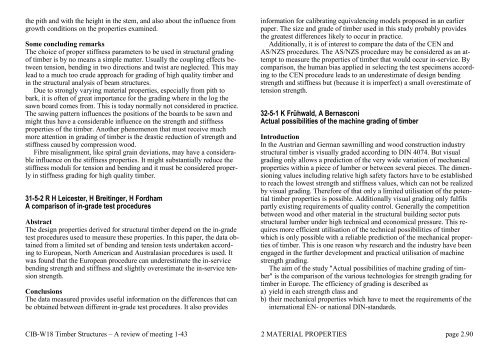CIB-W18 Timber Structures – A review of meeting 1-43 2 MATERIAL ...
CIB-W18 Timber Structures – A review of meeting 1-43 2 MATERIAL ...
CIB-W18 Timber Structures – A review of meeting 1-43 2 MATERIAL ...
- TAGS
- timber
- structures
- cib-w18.com
You also want an ePaper? Increase the reach of your titles
YUMPU automatically turns print PDFs into web optimized ePapers that Google loves.
the pith and with the height in the stem, and also about the influence from<br />
growth conditions on the properties examined.<br />
Some concluding remarks<br />
The choice <strong>of</strong> proper stiffness parameters to be used in structural grading<br />
<strong>of</strong> timber is by no means a simple matter. Usually the coupling effects between<br />
tension, bending in two directions and twist are neglected. This may<br />
lead to a much too crude approach for grading <strong>of</strong> high quality timber and<br />
in the structural analysis <strong>of</strong> beam structures.<br />
Due to strongly varying material properties, especially from pith to<br />
bark, it is <strong>of</strong>ten <strong>of</strong> great importance for the grading where in the log the<br />
sawn board comes from. This is today normally not considered in practice.<br />
The sawing pattern influences the positions <strong>of</strong> the boards to be sawn and<br />
might thus have a considerable influence on the strength and stiffness<br />
properties <strong>of</strong> the timber. Another phenomenon that must receive much<br />
more attention in grading <strong>of</strong> timber is the drastic reduction <strong>of</strong> strength and<br />
stiffness caused by compression wood.<br />
Fibre misalignment, like spiral grain deviations, may have a considerable<br />
influence on the stiffness properties. It might substantially reduce the<br />
stiffness moduli for tension and bending and it must be considered properly<br />
in stiffness grading for high quality timber.<br />
31-5-2 R H Leicester, H Breitinger, H Fordham<br />
A comparison <strong>of</strong> in-grade test procedures<br />
Abstract<br />
The design properties derived for structural timber depend on the in-grade<br />
test procedures used to measure these properties. In this paper, the data obtained<br />
from a limited set <strong>of</strong> bending and tension tests undertaken according<br />
to European, North American and Australasian procedures is used. It<br />
was found that the European procedure can underestimate the in-service<br />
bending strength and stiffness and slightly overestimate the in-service tension<br />
strength.<br />
Conclusions<br />
The data measured provides useful information on the differences that can<br />
be obtained between different in-grade test procedures. It also provides<br />
information for calibrating equivalencing models proposed in an earlier<br />
paper. The size and grade <strong>of</strong> timber used in this study probably provides<br />
the greatest differences likely to occur in practice.<br />
Additionally, it is <strong>of</strong> interest to compare the data <strong>of</strong> the CEN and<br />
AS/NZS procedures. The AS/NZS procedure may be considered as an attempt<br />
to measure the properties <strong>of</strong> timber that would occur in-service. By<br />
comparison, the human bias applied in selecting the test specimens according<br />
to the CEN procedure leads to an underestimate <strong>of</strong> design bending<br />
strength and stiffness but (because it is imperfect) a small overestimate <strong>of</strong><br />
tension strength.<br />
32-5-1 K Frühwald, A Bernasconi<br />
Actual possibilities <strong>of</strong> the machine grading <strong>of</strong> timber<br />
Introduction<br />
In the Austrian and German sawmilling and wood construction industry<br />
structural timber is visually graded according to DIN 4074. But visual<br />
grading only allows a prediction <strong>of</strong> the very wide variation <strong>of</strong> mechanical<br />
properties within a piece <strong>of</strong> lumber or between several pieces. The dimensioning<br />
values including relative high safety factors have to be established<br />
to reach the lowest strength and stiffness values, which can not be realized<br />
by visual grading. Therefore <strong>of</strong> that only a limited utilisation <strong>of</strong> the potential<br />
timber properties is possible. Additionally visual grading only fulfils<br />
partly existing requirements <strong>of</strong> quality control. Generally the competition<br />
between wood and other material in the structural building sector puts<br />
structural lumber under high technical and economical pressure. This requires<br />
more efficient utilisation <strong>of</strong> the technical possibilities <strong>of</strong> timber<br />
which is only possible with a reliable prediction <strong>of</strong> the mechanical properties<br />
<strong>of</strong> timber. This is one reason why research and the industry have been<br />
engaged in the further development and practical utilisation <strong>of</strong> machine<br />
strength grading.<br />
The aim <strong>of</strong> the study "Actual possibilities <strong>of</strong> machine grading <strong>of</strong> timber"<br />
is the comparison <strong>of</strong> the various technologies for strength grading for<br />
timber in Europe. The efficiency <strong>of</strong> grading is described as<br />
a) yield in each strength class and<br />
b) their mechanical properties which have to meet the requirements <strong>of</strong> the<br />
international EN- or national DIN-standards.<br />
<strong>CIB</strong>-<strong>W18</strong> <strong>Timber</strong> <strong>Structures</strong> <strong>–</strong> A <strong>review</strong> <strong>of</strong> <strong>meeting</strong> 1-<strong>43</strong> 2 <strong>MATERIAL</strong> PROPERTIES page 2.90














